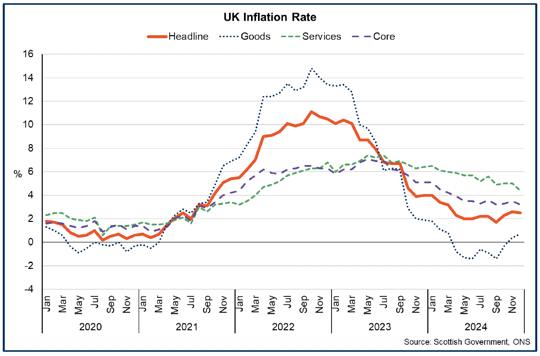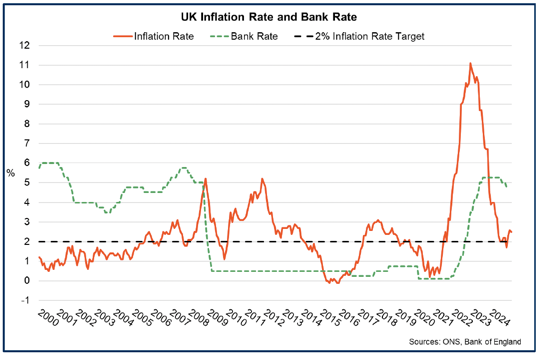Scottish economic bulletin: February 2025
Provides a summary of latest key economic statistics, forecasts and analysis on the Scottish economy.
Inflation
Inflation fell to 2.5% in December, partly driven by slower growth in services prices.
- The inflation rate fell to 2.5% in December (from 2.6% the previous month) with the decrease mainly driven by lower inflation in restaurants and hotels (3.4%, down from 4.0%), while transport prices continued to fall (-0.6%), though more slowly than in recent months.[2]
- More broadly, there continues to be a notable difference in goods and services price inflation with services inflation remaining more elevated, however the difference has continued to narrow in recent months. Goods price inflation rose for a second consecutive month in December to 0.7% (from 0.4%) while services price inflation fell from 5% to 4.4%, its lowest rate since March 2022. Core inflation, which excludes energy, food, alcohol, and tobacco, fell to 3.2% in December (from 3.5%).

- Inflation remains above the 2% target. With underlying inflationary pressures persisting, the Bank of England's Monetary Policy Committee (MPC) has taken a gradual approach to loosening monetary policy with two rate cuts in 2024 (from 5.25% to 5% in August and to 4.75% in November).
- The MPC maintained the Bank Rate at 4.75% in December reflecting that while previous external shocks have eased, domestic inflationary pressures are reducing more slowly. Markets expect further gradual reductions in 2025, although these will be dependent on inflation being seen as on a path to return sustainably to target. The MPC release their next rate decision and economy forecasts on 6 February.[3]

Contact
Email: economic.statistics@gov.scot
There is a problem
Thanks for your feedback